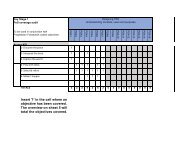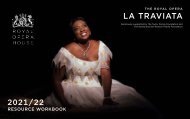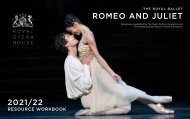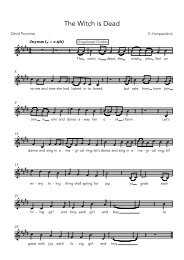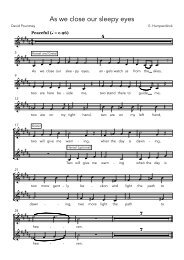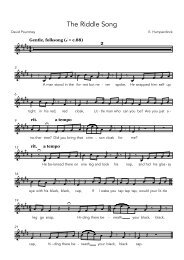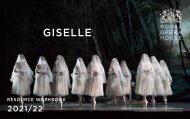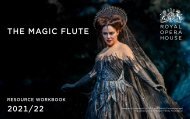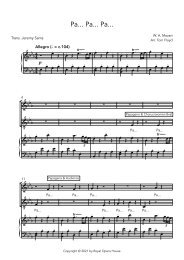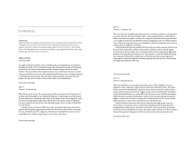The Sailors’ Chorus
Create successful ePaper yourself
Turn your PDF publications into a flip-book with our unique Google optimized e-Paper software.
THE ROYAL OPERA<br />
SAILORS’<br />
CHORUS<br />
from Wagner’s <strong>The</strong> Flying Dutchman<br />
SECONDARY MUSIC UNIT: KS3
Introduction<br />
This resource contains music lesson structure ideas and resources for a unit of<br />
work centered around the <strong>Sailors’</strong> <strong>Chorus</strong> from Wagner’s 1843 opera <strong>The</strong> Flying<br />
Dutchman. <strong>The</strong> unit has a series of suggested classroom activities (ideally about 5-6<br />
hours) written for KS3 secondary music students involving performing, listening,<br />
creating and arranging, and links to additional online resources, which will further<br />
enhance the learning experience. A suggested scheme of work is included in the<br />
back of this resource.<br />
<strong>The</strong> main focus of the unit involves dramatic singing – having the students become<br />
the characters in this part of the opera, a group of sailors performing a work<br />
song. <strong>The</strong> piece is presented in a number of sections that include body percussion<br />
interludes and provide the opportunity to experiment with structure.<br />
At the end of the unit the class will have prepared a performance of their own<br />
arrangement of the <strong>Sailors’</strong> <strong>Chorus</strong> inspired by the materials contained in<br />
this resource.<br />
This unit includes:<br />
An arrangement suitable for adolescent voices <br />
Listening activities based upon this and other excerpts <br />
Background information on the opera <br />
Links to a performance of this chorus <br />
Simple piano accompaniment <br />
A range of backing tracks at various tempos <br />
A composing challenge for the students <br />
Additional classroom material exploring sea shanty work songs<br />
A CPD is offered to accompany this material, focusing on healthy dramatic singing<br />
techniques for the classroom and allowing time to tailor the materials into a scheme<br />
of work aligned to your students’ needs.<br />
Royal Opera House – KS3 Dramatic Singing Resource 2
Lesson Focus<br />
Every voice is important. Singers are individuals, who as a chorus come together to<br />
make a whole lot of individual characters. In this way, they differ to a choir which<br />
is concerned with blend and uniformity of sound. In this project, we are concerned<br />
with dramatic singing – whole body singing, where the singer is less concerned<br />
about technique (let’s face it, most schools aged students do not have the physical<br />
development required for true operatic singing!) and focussing upon telling a story<br />
by creating a scene and living the role that they are singing. This is about students<br />
singing together and having fun immersing themselves into the song.<br />
Students will start with an icebreaker singing activity based upon the familiar sea<br />
shanty What shall we do with the drunken sailor and excerpts from the <strong>Sailors’</strong><br />
<strong>Chorus</strong>. <strong>The</strong>y then learn the song in four sections and an additional arranged body<br />
percussion section incorporating the traditional tune What shall we do with the<br />
drunken sailor. To create the bustle of a sailing ship they will learn and use ostinato<br />
patterns based upon rhythmic phrases from the <strong>Sailors’</strong> <strong>Chorus</strong>.<br />
Once they have learnt to sing the piece they will consider the dramatic context, how<br />
the sailors would be feeling and acting as they embark on a trip to shore, having<br />
worked hard on the boat during their voyage. Consider how this would impact on<br />
the way they sing it. <strong>The</strong>y may even consider how it might be staged, what the<br />
sailors would be doing whilst singing and the work they might mime throughout the<br />
instrumental sections.<br />
After they have mastered their own performance of the <strong>Sailors’</strong> <strong>Chorus</strong> consider the<br />
traditions from which this sort of song has evolved and is being replicated by Wagner.<br />
Alignment to KS3 National Curriculum Aims<br />
All pupils will:<br />
Perform, listen to, review and evaluate music across a range of historical<br />
periods, genres, styles and traditions, including the works of the great<br />
composers, by learning to sing and studying a chorus from the romantic<br />
period opera <strong>The</strong> Flying Dutchman by Wagner and comparing these with<br />
traditional <strong>Sailors’</strong> work songs of the 1800s.<br />
Learn to sing and to use their voices, to create and compose music on their<br />
own and with others by performing and arranging their own versions of the<br />
<strong>Sailors’</strong> <strong>Chorus</strong> and another work song.<br />
Use technology appropriately to record and notate their compositions.<br />
Understand and explore how music is created, produced and communicated,<br />
including through the inter-related dimensions: pitch, duration, dynamics,<br />
tempo, timbre, texture, structure and appropriate musical notations, through<br />
a study of the works contained in this unit.<br />
Royal Opera House – KS3 Dramatic Singing Resource 3
Learning Outcomes – Students<br />
Performing:<br />
Develop singing skills and singing confidence as a member of the<br />
class chorus.<br />
Perform the <strong>Sailors’</strong> <strong>Chorus</strong> with an understanding of context and how to<br />
convey drama through singing.<br />
Performance of body percussion and ostinato patterns from this work.<br />
Learning additional traditional work songs.<br />
Performing the class’ own arrangement of the <strong>Sailors’</strong> <strong>Chorus</strong> and work songs.<br />
Arranging and composing:<br />
Creating an arrangement of the <strong>Sailors’</strong> <strong>Chorus</strong> using the material provided,<br />
and critically evaluating their musical choices to refine their composition<br />
Writing an arrangement of a traditional work song or an original work song.<br />
Listening:<br />
To a professional recording of the <strong>Sailors’</strong> <strong>Chorus</strong> and answering questions<br />
about the music.<br />
To and comparing differing performances of the <strong>Sailors’</strong> <strong>Chorus</strong> to develop<br />
critical listening skills.<br />
Royal Opera House – KS3 Dramatic Singing Resource 4
Warm Up<br />
As with any activity, it is important to warm up the voice before singing.<br />
Learn these tongue twister exercises, adjusting the starting pitch to the voice<br />
ranges in your class:<br />
Start with a tongue twister:<br />
Sister Susie went to sea<br />
To see the sea, you see.<br />
<strong>The</strong> sea she saw was a saucy sea,<br />
A sort of saucy sea saw she.<br />
A box of biscuits,<br />
A box of mixed biscuits,<br />
And a biscuit mixer.<br />
<strong>The</strong>n move into pitched activities that start to get the students singing together.<br />
A: Ascending the scale singing on each pitch the following words quickly and<br />
clearly (i.e. getting the mouths articulating and not mumbling)<br />
B: Using the diaphragm to pump out the first three words and then holding the<br />
“m” of rum trying to make lips buzz.<br />
C: Moving chromatically up or down the scale<br />
Royal Opera House – KS3 Dramatic Singing Resource 5
Drunken Dutchman Icebreaker<br />
Teach the three-part warm up below.<br />
Part 1 is the traditional folk song What shall we do with the drunken sailor?<br />
Part 2 is the first section of the <strong>Sailors’</strong> <strong>Chorus</strong><br />
Part 3 is based upon the opening of section C of the <strong>Sailors’</strong> <strong>Chorus</strong><br />
Learn each of these parts and then divide the class into three groups and assign one<br />
part to each group.<br />
Once the students are performing this as a round, add a simple 4 beat body<br />
percussion accompaniment such as:<br />
BEAT: 1 2 3 4<br />
stamp chest chest (rest) clap<br />
Royal Opera House – KS3 Dramatic Singing Resource 6
Performing<br />
Learn each of the sections of the <strong>Sailors’</strong> <strong>Chorus</strong>, either by rote or practising<br />
sight singing. Note that a piano reduction of the orchestral accompaniment has<br />
been made for teachers’ to use however, there is also a series of backing track<br />
recordings accompanying this resource which frees the teacher up to direct the<br />
lesson if preferred.<br />
CONTEXT: <strong>The</strong> sailors have been at sea for a long time and are now about to leave<br />
their work and go enjoy some leave (free time) on land. <strong>The</strong>y are really looking forward<br />
to time off the boat away from their work. Think about this as you sing the song.<br />
Section A<br />
Section B<br />
Section C<br />
Royal Opera House – KS3 Dramatic Singing Resource 7
Section D<br />
Each section is played at a slower learning speed on the accompaniment<br />
recordings, as a melody alone and at performance tempo so there are a variety of<br />
accompaniments to choose from if there are no competent pianists in the room.<br />
Below are some patterns extracted from the <strong>Sailors’</strong> <strong>Chorus</strong>, with the addition of<br />
rhythms from our Drunken Sailor warm up:<br />
Royal Opera House – KS3 Dramatic Singing Resource 8
Transfer the layers to percussion instruments to create an accompaniment to<br />
the song.<br />
Experiment with layering up gradually and mixing and matching layers. You could<br />
even try having the sailors perform them in canon, antiphonally or in individual<br />
working groups.<br />
Note that this material could be used as an introduction to the <strong>Sailors’</strong> <strong>Chorus</strong>, or an<br />
interlude in the middle of your arrangement.<br />
Developing a performance<br />
Once the students are singing confidently, it is time to start experimenting with a<br />
structure.<br />
Section A and Section B can make a good introduction – piano only.<br />
You could add rhythmic patterns above this which could be spoken, or<br />
played on percussion instruments (pitched or unpitched).<br />
Section A is not repeated in the original but works well if repeated.<br />
On the repeat, additional vocal parts could be added.<br />
Drunken Sailor works well when sung above section A and Section B, with<br />
some small modification (as in the score). It should be sung in D minor.<br />
Section C is more harmonically interesting – and the rhythmic patterns<br />
would work best here due to the changing harmonies.<br />
Section A could be sung again at the end to good effect as a coda.<br />
As a class, experiment with different combinations of the song and create a<br />
performance structure.<br />
Adding some drama<br />
In order to get into the characters, each singer needs to consider the context<br />
and what their character might be doing at this point in the song. Consider<br />
the following:<br />
How can you show an audience that you are sailors in your actions, posture,<br />
interaction and use of props?<br />
<strong>The</strong> sailors are having a recess from their duties as the boat has pulled into<br />
shore. How would they be feeling? How would they show this in<br />
their actions?<br />
Royal Opera House – KS3 Dramatic Singing Resource 9
What sort of actions might working sailors be doing?<br />
As it is a song with a strong rhythm, it suggests strong rhythmic actions<br />
might be suitable. Try a range of actions that can be done while singing<br />
and perhaps more vigorous less stationary ones for when the instrumental<br />
interludes play.<br />
How might the groups of sailors be placed around a ship?<br />
How can this be applied to the placement of the singers on a stage?<br />
Accompaniment versions<br />
Section A<br />
Royal Opera House – KS3 Dramatic Singing Resource 10
Section B<br />
Royal Opera House – KS3 Dramatic Singing Resource 11
Section C<br />
Royal Opera House – KS3 Dramatic Singing Resource 12
Section D<br />
Royal Opera House – KS3 Dramatic Singing Resource 13
Listening<br />
Now listen to an opera chorus of professional dramatic singers perform this work:<br />
Audio video recording<br />
Listen now<br />
Listen now<br />
Below is a link to the Royal Opera House’s Performance of the <strong>Sailors’</strong> <strong>Chorus</strong><br />
Watch now<br />
Watch now<br />
Listening questions:<br />
As this piece is not a stand-alone song, but a chorus from within a larger piece<br />
of continuous music, the composer needs to create a convincing musical link<br />
from the piece before into the <strong>Sailors’</strong> <strong>Chorus</strong>. <strong>The</strong>re are actually two minutes<br />
of singing before the chorus start this song. Now you know the song, consider<br />
how the composer has created his introduction. What ideas from the song<br />
have been used and how have they been used in this introduction?<br />
When the chorus starts singing, describe the timbre (quality or colour) of<br />
the musical sounds (orchestra and voices).<br />
What are the words about, and does the music reflect their meaning? How?<br />
Look at the melody and describe how it is constructed, identifying and describing<br />
composition devices like phrase, contour, key, use of motif and cadence.<br />
As you listen to the piece identify the structure of the opera chorus used by<br />
Wagner, using the sections A B C & D.<br />
What musical differences can you find between the different sections?<br />
Do you notice that different sections require the chorus to use their voices<br />
slightly differently? What changes can you hear?<br />
How does the orchestra support and work with the voices?<br />
Record a performance of your arrangement and then compare the two versions<br />
How do the versions differ?<br />
What are the strengths and less successful aspects of each performance?<br />
What can you do to improve your version?<br />
Royal Opera House – KS3 Dramatic Singing Resource 14
Score reading<br />
If your students are advanced enough, they can follow the score excerpt from the<br />
opera as they answer the above questions (included in the resource as a PDF) to<br />
give greater musical depth to their answers by making specific reference to tonality,<br />
pitch, harmony and identifying supporting musical examples from the score.<br />
Royal Opera House – KS3 Dramatic Singing Resource 15
Royal Opera House – KS3 Dramatic Singing Resource 16
Royal Opera House – KS3 Dramatic Singing Resource 17
Royal Opera House – KS3 Dramatic Singing Resource 18
Royal Opera House – KS3 Dramatic Singing Resource 19
Royal Opera House – KS3 Dramatic Singing Resource 20
Royal Opera House – KS3 Dramatic Singing Resource 21
Royal Opera House – KS3 Dramatic Singing Resource 22
Royal Opera House – KS3 Dramatic Singing Resource 23
Royal Opera House – KS3 Dramatic Singing Resource 24
Royal Opera House – KS3 Dramatic Singing Resource 25
Royal Opera House – KS3 Dramatic Singing Resource 26
Royal Opera House – KS3 Dramatic Singing Resource 27
Royal Opera House – KS3 Dramatic Singing Resource 28
Royal Opera House – KS3 Dramatic Singing Resource 29
Royal Opera House – KS3 Dramatic Singing Resource 30
Consider the wider context<br />
Work songs<br />
<strong>The</strong>re is a long tradition of people using singing as a technique for unifying physical<br />
movement while working.<br />
Investigate the following:<br />
1. What is a work song?<br />
2. Why do workers sing work songs? Are they particularly useful for specific<br />
types of jobs?<br />
3. Why do you think sailors sang so many sea shanties?<br />
Read this interesting article on 19th century life of a sailor:<br />
Read now<br />
4. What are the musical characteristics of a good work song?<br />
(consider, rhythm, beat, tempo, tune and structure in your answer).<br />
5. What work songs do you already know? Try composing a work song for<br />
cleaning the whiteboard or some other classroom “work”.<br />
Royal Opera House – KS3 Dramatic Singing Resource 31
Background material<br />
Shanties may be divided into several rough categories:<br />
Long-drag shanties:<br />
Sung when a job of hauling on a rope was expected to last a long time.<br />
Usually one pull per verse, to give the men a chance to rest. Examples:<br />
Blow the Man Down. A famous Russian equivalent is the Volga Boatman’s<br />
Song, which was sung by land parties pulling barges along the river.<br />
Short-drag (or “hand over hand”) shanties:<br />
Sung when a job of hauling on a rope was expected to be quick. Two or<br />
more pulls per verse. Examples: Haul Away Joe, Drunken Sailor.<br />
Capstan (also called “stamp and go”) shanties:<br />
Raising the anchor on a ship involved winding the rope along a giant winch,<br />
turned by sailors walking around it. Capstan shanties are anchor-raising<br />
shanties. <strong>The</strong>y are typically more lyrical, or less rhythmic than other types of<br />
shanties because there was no pulling required and, unlike many other types<br />
of shanties, frequently have a full chorus in addition to the call-and-response<br />
verses. Examples: Rio Grande, John Brown’s Body.<br />
Pumping Shanties:<br />
All wooden ships leak. <strong>The</strong>re was a place in the cargo area in ships where the<br />
leaked-in water known as bilge, would collect. Bilge water had to be pumped<br />
out frequently; on period ships this was done with a two-man pump. Many<br />
pumping shanties were also used as capstan shanties, and vice versa,<br />
particularly after the adoption of the Downton pump which used a capstan<br />
rather than pump handles moved up and down. Examples include: Strike <strong>The</strong><br />
Bell, Shallow Brown and Lowlands.<br />
Creative Challenge<br />
1. Learn the work song Haul Away Joe (on the next page) and experiment with<br />
different individuals and groups performing the leader and response rolls.<br />
2. Create your own, small group or class arrangement of this or another<br />
work song of your choice. Try to vary the arrangement with additional<br />
accompaniment ideas in a similar way to the <strong>Sailors’</strong> <strong>Chorus</strong> and notate your<br />
ideas so that others can replicate your version of Haul Away Joe and you can<br />
remember your piece for performance.<br />
3. Once this task is complete and you are happy with the results, perform<br />
and record the piece as a group of sailors. Compare each performance and<br />
discuss the “dramatic singing” of each group.<br />
Royal Opera House – KS3 Dramatic Singing Resource 32
Additional Useful Online Information<br />
Link to Royal Opera House performance and performance information:<br />
Read now<br />
History of the legend of <strong>The</strong> Flying Dutchman:<br />
Read now<br />
About <strong>The</strong> Royal Opera House’s chorus:<br />
Read now<br />
Bryn Terfel on the role of the Dutchman:<br />
Read now<br />
Essential background information to the Royal Opera’s Production:<br />
Read now<br />
Royal Opera House – KS3 Dramatic Singing Resource 33
Listen now<br />
Haul Away Joe<br />
Watch now<br />
This song is in a call and response style. A soloist or group of soloists and the rest of<br />
the ensemble respond with the parts in bold.<br />
Now when I was a little boy an’ so my mother told me,<br />
‘Way haul away, we’ll haul away, Joe!<br />
That if I did not kiss the gals me lips would all grow mouldy.<br />
‘Way haul away, we’ll haul away Joe!<br />
‘Way haul away, the good ship now is rolling Jimmy!<br />
‘Way haul away, we’ll haul away Joe!<br />
And Louis was the king of France before the revolution<br />
‘Way haul away, we’ll haul away Joe!<br />
And when he got his head cut off, it spoilt his constitution<br />
‘Way haul away, we’ll haul away Joe!<br />
Now first I met a Yankee girl and she was fat and lazy<br />
‘Way haul away, we’ll haul away Joe!<br />
And then I met an Irish girl she dang near drove me crazy!<br />
‘Way haul away, we’ll haul away Joe!<br />
‘Way haul away, we’re bound for better weather<br />
‘Way haul away, we’ll haul away Joe!<br />
Royal Opera House – KS3 Dramatic Singing Resource 34
Key stage 3<br />
Lesson One: <strong>The</strong> Dramatic Voice & Sea Shanties<br />
Lesson Outcomes:<br />
• To explore various vocal colours and ‘playing’ with the voice<br />
• To establish good vocal technique and knowledge<br />
• To begin exploring sea shanties and work songs<br />
5 mins First Touch Watch a short video about sea shanties and<br />
work songs<br />
15 mins Starter Physical warm-up<br />
Rhythm call-and-response exercise using body<br />
percussion<br />
Introduce the voice technique – feeling the larynx<br />
Sister Susie went to sea exercise<br />
• Call and response is different characters<br />
• Begin to introduce singing on a single note<br />
15 mins Main Activity Teach Drunken Dutchman<br />
• Start with What shall we do with a drunken sailor?<br />
• Teach the ‘Husasa He’ line<br />
• Teach ‘Sailor man’ line<br />
• Layer all the melodies over the top of one another<br />
15 mins Group work Look at the body percussion accompaniment to<br />
Drunken Dutchman<br />
Split the class into groups and task to compose and<br />
rehearse a simple body percussion piece to fit with the<br />
songs<br />
Add some (or all) body persuasion to the Drunken<br />
Dutchman<br />
10 mins Finisher Full class performance<br />
My Bonney lies over the ocean game<br />
Royal Opera House – KS3 Dramatic Singing Resource 35
Lesson Two: Introducing the <strong>Sailors’</strong> <strong>Chorus</strong><br />
Lesson Outcomes:<br />
• To develop vocal technique – exploring different vocal registers<br />
• To begin to explore the music of the <strong>Sailors’</strong> <strong>Chorus</strong><br />
5 mins First Touch Listen to a recording of Drunken Sailor or a similar<br />
sea shanty<br />
15 mins Starter Physical warm-up<br />
Yo ho ho exercise<br />
Ahoy me hearties<br />
Recap Drunken Dutchman<br />
15 mins Main Activity Begin <strong>Sailors’</strong> <strong>Chorus</strong><br />
Start with Section A, then section C<br />
(learn Section B if you have time)<br />
15 mins Group work Split the class in three and task them with coming up<br />
with actions of suitable ‘worksong’ movements to do<br />
alongside each tune<br />
Get the class to perform to one another and teach each<br />
other the movements<br />
10 mins Finisher Haul away Joe game<br />
Royal Opera House – KS3 Dramatic Singing Resource 36
Lesson Three: It’s from an opera!<br />
Lesson Outcomes:<br />
• To develop our knowledge of dramatic singing<br />
• To continue to learn the <strong>Sailors’</strong> <strong>Chorus</strong><br />
• To begin to explore the context of Wagner’s opera<br />
5 mins First Touch Watch the ROH performance of the <strong>Sailors’</strong> <strong>Chorus</strong><br />
15 mins Discussion Listening questions from booklet<br />
10 mins Warm up Physical warm up<br />
Revisit Sister Susie activity looking at different<br />
characters from the scene<br />
Yo ho ho laughing warm up (from section D)<br />
15 mins Main Activity Revise Sections A C<br />
Introduce B (if not already) with actions from<br />
last lesson<br />
Teach section D starting from b 41<br />
10 mins Finisher Sing through the whole song My Bonney lies over the<br />
ocean game<br />
Royal Opera House – KS3 Dramatic Singing Resource 37
Lesson Four: Adding the percussion<br />
Lesson Outcomes:<br />
• To look at the structure of <strong>Sailors’</strong> <strong>Chorus</strong><br />
• To compose in groups rhythmic ostinati<br />
5 mins First Touch Watch a short video about sea shanties and<br />
work songs<br />
15 mins Starter Physical warm-up<br />
Rhythm call-and-response exercise using body<br />
percussion<br />
Introduce the voice technique – feeling the larynx<br />
Sister Susie went to sea exercise<br />
• Call and response is different characters<br />
• Begin to introduce singing on a single note<br />
10 mins Main Activity Sing through the <strong>Sailors’</strong> <strong>Chorus</strong> – concentrate on<br />
diction and dramatic intent<br />
Pick out rhythms from the music and turn into body<br />
percussion<br />
Layer three of four rhythms one the top of one another<br />
as a whole class<br />
15 mins Group work Create your own ostinati from rhythms in the text in<br />
small groups<br />
Try and notate rhythms and transfer them into<br />
body percussion<br />
Share back any groups that complete the task group<br />
to group<br />
10 mins Finisher Put the different rhythms together as a whole class<br />
Royal Opera House – KS3 Dramatic Singing Resource 38
Lesson Five: <strong>The</strong> Flying Dutchman – adding drama<br />
Lesson Outcomes:<br />
• To delve further into <strong>The</strong> Flying Dutchman story<br />
• To look at structuring the final performance<br />
• To begin to explore staging and context of the <strong>Sailors’</strong> <strong>Chorus</strong><br />
5 mins First Touch Watch Bryn Terfel video<br />
15 mins Starter Physical warm-up<br />
Rhythm call-and-response exercise using patterns from<br />
the <strong>Sailors’</strong> <strong>Chorus</strong><br />
Add Drunken Sailor over the top of Body Percussion<br />
10 mins Main Activity Sing through <strong>Sailors’</strong> <strong>Chorus</strong> with accompaniment<br />
in full structure<br />
20 mins Group work Continue and finish group activity from last lesson<br />
OR<br />
Work together as a class to structure a full performance<br />
of the piece<br />
10 mins Whole<br />
Class work<br />
Put body percussion together as a whole class<br />
(potentially add chanting) to create a work scene<br />
Royal Opera House – KS3 Dramatic Singing Resource 39
Lesson Six: Putting it all together<br />
Lesson Outcomes:<br />
• To create a full performance of our work<br />
• To explore staging and characterisation of the scene<br />
• To evaluate our learning<br />
15 mins Starter Physical warm-up<br />
Recap vocal warm ups and prepare the song<br />
Go over any particular issues<br />
30 mins Main Activity Work through ‘adding some drama’ section<br />
Think about structure<br />
Rehearse and refine the scene<br />
15 mins Finisher Evaluate our performance and learning from the project<br />
Finish with any singing games<br />
Royal Opera House – KS3 Dramatic Singing Resource 40
Key stage 3 – Advanced<br />
Presented as 6 one hour lessons<br />
Lesson One<br />
Intro to the unit<br />
• Dutchman story – getting into character<br />
Join a chorus of sailors<br />
Warm up<br />
Learn the Drunken Dutchman<br />
Section A theme<br />
• Learn the 8 bar tune<br />
• Perform with piano<br />
• Notate word rhythms<br />
• How might you manipulate your voice to sound like a sailor?<br />
Repeat process to learn parts B, C and D<br />
• Replace rhythm notation with pitch shape of comparing the different<br />
musical sections<br />
• Put the whole piece together and perform with piano accompaniment<br />
Record your singing of those sections<br />
Listening to ROH version. What differences do you hear? What ideas might you<br />
apply to your class performance?<br />
Lesson Two<br />
Consider what a work song is and its purpose. How does this differ to opera<br />
(dramatic) singing?<br />
Warm up<br />
Tongue twister<br />
Sailing on a ship<br />
Yo ho Ho<br />
Revise the song from yesterday<br />
• Perform without reading words<br />
Discuss the role of singing in the life of a sailor<br />
Learn sea shanty Haul Away Joe<br />
Consider how sailors would have used it as a tool for working and imitate some<br />
sailor work as you sing<br />
Listen to the recording of a chorus singing and complete the questions provided<br />
Royal Opera House – KS3 Dramatic Singing Resource 41
Lesson Three<br />
Focus on arranging a class version of <strong>Sailors’</strong> <strong>Chorus</strong> for performance<br />
Warm up<br />
Learn Ahoy me hearties<br />
Learn the body percussion activity<br />
Remind students about the purpose of work songs and create movement to<br />
accompany the ostinato patterns<br />
In groups or as a class create an arrangement of <strong>Sailors’</strong> <strong>Chorus</strong>, deciding what<br />
structure you will use.<br />
• Encourage groups to experiment with options<br />
Use available technology to record your ideas<br />
Perform the final product, allowing time for reflection about its strengths<br />
and weakness.<br />
Lesson Four<br />
Apply the ideas on the <strong>Sailors’</strong> <strong>Chorus</strong> to another arrangement<br />
Body percussion exercise revision<br />
Vocal warm up<br />
Discuss the structure used in your arrangements of <strong>Sailors’</strong> <strong>Chorus</strong><br />
Apply this to an arrangement of Haul Away Joe or another work song. What new<br />
material might your group add to this work?<br />
Use available technology to record your ideas<br />
Present your arrangements to the rest of the class<br />
Royal Opera House – KS3 Dramatic Singing Resource 42
Lesson Five<br />
What is dramatic singing?<br />
Warm up<br />
Sailing on a ship<br />
Yo Ho Ho<br />
Drama warm up<br />
Revise and refine your arrangement of the <strong>Sailors’</strong> <strong>Chorus</strong><br />
Consider the dramatic delivery of your song and how you will “stage”<br />
your performance<br />
Watch the ROH version of the performance and answer the questions. Find other<br />
versions of the <strong>Sailors’</strong> <strong>Chorus</strong> online and compare the dramatic interpretation<br />
and the musical features of the performances<br />
Discuss how you might enhance the class performance<br />
Review. Evaluate. Refine<br />
Lesson Six<br />
Performing your arrangements<br />
Warm up<br />
Allow the students to choose their favourites<br />
Rehearse your arrangements, considering the purpose of the song, its context<br />
and dramatic singing style<br />
Perform and film both your arrangement of <strong>Sailors’</strong> <strong>Chorus</strong> and of your chosen<br />
folk song<br />
Film it, but also deliver your performance to a live audience and see how your<br />
standards rise<br />
Have you considered the needs of the audience?<br />
Compare your final performance with the one made in Lesson 1<br />
Evaluate how well your class has created and performed your scene and the ways<br />
in which their singing has developed<br />
Royal Opera House – KS3 Dramatic Singing Resource 43
<strong>The</strong> Royal Opera House Covent Garden Foundation is a registered charity number<br />
211775, company limited by guarantee incorporated in England and Wales, company<br />
number 480523, VAT registration number 769 3775 65, registered office as shown.<br />
Design by Great Appeal.<br />
Royal Opera House – KS3 Dramatic Singing Resource 44





